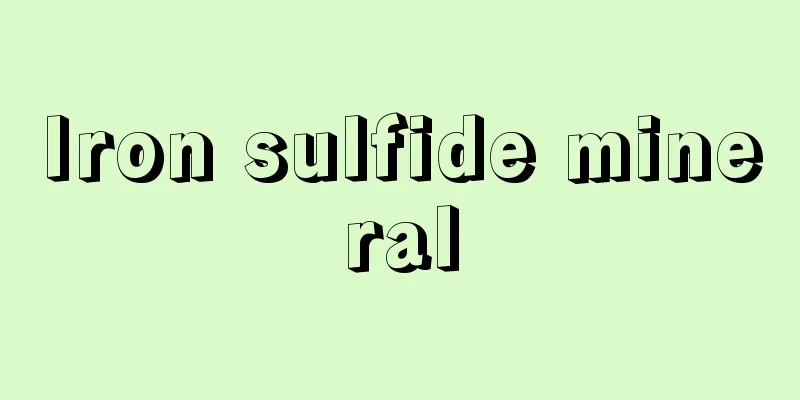Intimidation - Threatening

|
It means "passing through the cords" and refers to passing the cords through the holes in the straps and stringing them up and down to form armor. It can also be written as 'odoshige' or 'ke' because the arrangement of the cords looks like a bird's feathers or loose feathers. However, in the ancient 'Hizen no Kuni Fudoki' it is written as 'tsurao', and in the 'Kokushu Chinpocho' from 756 (Tenpyo Shoho 8) it is written as 'kumitsura'. It is thought that the terms 'odoshige' and 'doshige' came to be used in the late Heian period. The techniques of omen are broadly divided into kebiki and sugake. Kebiki omen is a technique in which the omen passes through each small piece of metal, and is applied horizontally from left to right between the upper and lower metal plates. Depending on how the metal plate head is twisted, it can be divided into vertical and rope-like patterns. Tatetori is a technique in which the strings are threaded vertically through the two holes at the top of the tag head, and can be seen in the old Sakaomodakaodoshi Oyoroi (armor with inverted sakamodaka) of Oyamazumi Shrine in Ehime Prefecture and the model of the Sakaomodakaodoshi Armor (armor with inverted sakamodaka) attributed to Prince Shotoku, as well as in the Tsurubashirishita (string running under armor) of Oyoroi until the early Muromachi period, and mimiito (one strand of thread at each end of the damask) was used until the end of the Edo period. Nawamedori is a technique that has been used universally since the late Heian period, and although it uses the two holes at the top like tatetori, the strings pass diagonally between the tags in the next row, creating a beautiful rope-like arrangement on the surface. Sukakeito began in the Muromachi period and was used mostly on armor made of plate material throughout the Edo period. One unit consists of two hairs, which are arranged in a diamond shape at the top and point vertically downwards in a sparsely arranged arrangement. The materials for the armor include braided silk threads, thin strips of dyed deer leather, and thin strips of folded twill or plain silk with a hemp core. They are called "itoodoshi," "kawaodoshi," and "ayaodoshi," respectively. In addition to white, armor is dyed in red, scarlet, crimson, purple, light blue, light green, indigo, and black, and is expressed in a variety of beautiful colors by combining one or several colors. These colors reflect the style of the armor, the status and preferences of the wearer, and the tastes of the time, and they enhanced the beauty of the armor and brightly colored the military camps, as seen in the depictions of battle picture scrolls. The emotional beauty of armor and its colors is one of the major characteristics of Japanese armor. From the late Heian period to the Kamakura period, in addition to red, scarlet, purple, black, and the like, other colors included Nioiodoshi, which is white or light at the waist and gradually becomes darker from the top to the bottom, Susogo, which is a gradual change in color from the white top to the dark bottom, which is a gradual change in color that originates from the colors of the costumes of nobles, Shida Leather, Ko Sakura Owashi, and Ko Sakura Kigaeshi, which are dyed with scattered designs of ferns or cherry blossoms on the leather, and Zaza and Gyaku Zaza I, which use colored threads to represent the shapes of zaza leaves. From the end of the Kamakura period to the beginning of the Muromachi period, Tsumadori Iwashi, which has several colored threads used to color one side of the sleeves and kusazuri diagonally, became popular. After the Northern and Southern Courts period, black leather was favored, and other patterns such as katajiro (shoulder white), katadori (shoulder white), nakajiro (middle white), koshidori (waist white), various iroiro (various) and dan (cross) were mainly used on domaru (body armor) and haramaki (belly band). In the early modern period, intricately patterned patterns such as the rising sun flag, paulownia, comma shaped, manji (manji), and fan motifs and crests were popular for a time. However, as the style of armor changed to Tosei Gusoku (modern armor) which was mainly made of plates, the use of damask became less common. As a result, the surface of the armor became covered in wrinkled leather, embossed with gold and silver leaf, iron rust, inlaid with metal, and lacquer. Even in armor that used damask, black or navy blue thread became the mainstream. As a result, the damask, which was the core of the beauty of armor in the Middle Ages, lost its sense of color, lost its emotional beauty, and became less elegant. [Motoo Yamagishi] [Reference] | |© Hiroki Sato "> Main types of intimidation Source: Shogakukan Encyclopedia Nipponica About Encyclopedia Nipponica Information | Legend |
|
「緒(お)通し」の意で、札(さね)の穴へ緒を通し上下に連ねて甲冑(かっちゅう)を形成すること。縅とも書く。威し立てられた緒の配列が、鳥の羽毛や解き下げられた毛に似るところから威毛(おどしげ)とよび、毛ともいう。ただし、古く『肥前国風土記(ふどき)』に「貫緒(つらお)」とあり、756年(天平勝宝8)の『国家珍宝帳』には「組貫(くみつら)」と記されている。威や威毛とよぶようになったのは平安後期のことと考えられる。 威の手法は毛引(けびき)と素懸(すがけ)とに大別される。毛引威は小札(こざね)ごとに威毛の通るもので、上下の札板(さねいた)の間を左から右へ横に順次威していくが、札頭(さねがしら)の緘(から)み方により縦取(たてどり)と縄目取(なわめどり)とに分かれる。縦取は札頭の上の2孔に縦に緘む手法で、古く愛媛県大山祇(おおやまづみ)神社の逆沢瀉威大鎧(さかおもだかおどしおおよろい)と伝聖徳太子玩具(がんぐ)逆沢瀉威鎧雛型(ひながた)にみられるほか、室町初期ごろまで大鎧の弦走下(つるばしりした)に用いられ、また、耳糸(みみいと)(威毛のうち、両端の1筋の糸)は江戸末期まで行われた。縄目取は平安後期以降普遍的に用いられた手法で、上の2孔を利用することは縦取と同じであるが、次列の札との間を交互に斜めに緒が通り、表面には縄目状の美しい配列がみられる。素懸威は室町時代に始まり江戸時代を通じ多く板物(いたもの)製の甲冑に行われた。威毛2本を1単位とし、札頭で菱(ひし)に緘み、縦に下へ威し立て、その配列はまばらになる。 威毛の材料は、平打(ひらう)ちのおもに絹の組糸、鹿(しか)の染韋(そめかわ)を細く断った緒、綾(あや)や平絹を細く畳み麻布の芯(しん)を入れた緒などで、おのおの糸威(いとおどし)、韋(かわ)威、綾威などと称される。威毛は、白のほか赤、緋(ひ)、紅(くれない)、紫、浅葱(あさぎ)、萌黄(もえぎ)、縹(はなだ)、黒などに染められ、1色あるいは数色を組み合わせてさまざまの美しい色目を表現した。これには甲冑の形式、着用者の身分や好み、時代の好尚が反映され、合戦絵巻の描写にみられるように甲冑美を盛り上げ、華やかに軍陣を彩った。威毛とその色目の情緒的な美しさは日本甲冑の一大特色といえよう。平安後期から鎌倉時代には、赤、緋、紫、黒などのほか、腰を白あるいは淡くし、その上下をしだいに濃くする匂威(においおどし)や、裾濃(すそご)という上白く裾を漸次濃くした公家(くげ)装束の色目に由来する暈(ぼかし)風の色目、歯朶(しだ)や桜花を韋に散らし染めした歯朶韋威・小桜威・小桜黄返(きがえし)、沢瀉の葉の形を色糸で表した沢瀉・逆沢瀉威などが行われ、鎌倉末期から室町初期にかけては、袖と草摺(くさずり)の片側を数色の糸で斜めに彩った妻取(つまどり)威が流行した。 南北朝時代以降は黒韋(くろかわ)威が好まれたほか、肩白(かたじろ)、肩取(かたどり)、中白(なかじろ)、腰取(こしどり)、色々(いろいろ)威、緂(だん)(段)威などがおもに胴丸(どうまる)、腹巻(はらまき)に行われた。近世には、日の丸、桐(きり)、巴(ともえ)、万字、扇などの文様や紋章を表した技巧的な紋柄(もんがら)威が一時期流行した。しかし、甲冑の形式が板物(いたもの)を主とする当世具足(とうせいぐそく)に変わり、威毛の使用が少なくなったため、甲冑の表面は、皺革包(しぼかわづつみ)、金銀箔(はく)押し、鉄錆(かなさび)、象眼(ぞうがん)、蒔絵(まきえ)などとし、威毛を用いたものも黒糸や紺糸が主流となり、中世に甲冑美の中心をなした威毛は色彩感覚を低下し、情緒的な美しさを失い、雅趣の乏しいものとなった。 [山岸素夫] [参照項目] | |©佐藤廣喜"> 威のおもな種類 出典 小学館 日本大百科全書(ニッポニカ)日本大百科全書(ニッポニカ)について 情報 | 凡例 |
>>: Auto tricycle - Auto Sanrinsha
Recommend
Home-style shamisen notation - Home-style shamisen notation
...However, most of the scores published are for ...
Hirokami [village] - Hirokami
A village in Kita-Uonuma District, southern Niigat...
Kasane -
A mining term. Used to describe the cross-sectiona...
Sadao Maruyama
A modern theater actor. Born in Ehime Prefecture....
North offshore tide
...Kikyou-mizu and Kamikon-mizu (both in the Toho...
Bath additives - Yokuyozai
These are non-medicinal products and medicines use...
Collection of works by the regent Ichijo - Ichijo Sessho Gyoshu
This is a private collection of poems by Fujiwara...
Imam Reza Shrine - Imam Reza Shrine
The mausoleum of Imam Reza, the eighth Imam of the...
Xilinhot - Shirinhoto
A city in the Xilingol League on the grasslands of...
'Āref Qazvini (English spelling)
Around 1880-1934 A modern Iranian revolutionary po...
Imperialism (English spelling)
The word imperialism is used in a very ambiguous ...
Back three bunches - Ushirosanbou
…Three famous people whose names contain the char...
Kuzuryu River
A river that flows through northern Fukui Prefect...
Hainan Bay
...Population: 47,195 (1995). Facing Kainan Bay (...
Fire prevention - Kasaiyobo
...All costs incurred in responding to disasters ...







![Niimi [city] - Niimi](/upload/images/67cc6b24aa89e.webp)

